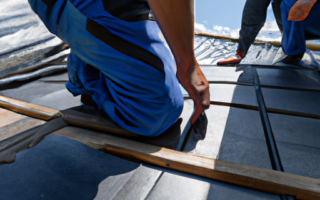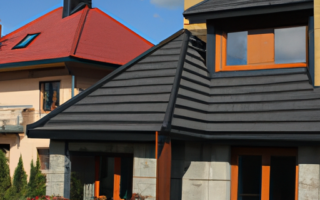Advantages and Disadvantages of Flat Roofing: Unveiling the Truth
When it comes to roofing options, flat roofing is a popular choice for many homeowners and commercial building owners. But like any roofing system, it has its own set of advantages and disadvantages. Understanding these pros and cons is crucial before making a decision. In this article, we will unveil the truth behind the advantages and disadvantages of flat roofing.
The Pros of Flat Roofing
1. Easy Installation and Accessibility:
One of the main advantages of a flat roof is its easy installation process. Compared to other roofing systems, flat roofs are simpler and quicker to install, resulting in lower labor costs. Additionally, flat roofs are easily accessible for repairs and maintenance, making it convenient for inspections and upkeep.
2. Extra Space:
By choosing a flat roof, you gain the advantage of extra usable space. Unlike pitched roofs, flat roofs provide the opportunity to create rooftop gardens, patios, or even additional living spaces. This can be particularly appealing for urban homeowners with limited outdoor space.
3. Cost-Effective:
Flat roofs are often more cost-effective than other roofing options, primarily due to their simpler design and installation process. The minimalistic structure and materials required for flat roofs contribute to lower expenses. The reduced surface area also means less material is needed, which can result in significant savings.
The Cons of Flat Roofing
1. Limited Drainage:
One of the main disadvantages of flat roofs is the limited drainage capability. Without proper slope or drainage systems in place, flat roofs can suffer from standing water. This water can lead to leaks, water damage, and deterioration of the roofing materials over time. Regular maintenance and a well-designed drainage system are essential to mitigate this issue.
2. Vulnerability to Leaks:
Flat roofs are more susceptible to leaks compared to pitched roofs. The absence of a steep slope makes it easier for water to accumulate and find its way through even the smallest gaps or cracks in the roofing membrane. Proper installation and regular inspections are necessary to prevent and address potential leaks promptly.
3. Lifespan:
Flat roofs generally have a shorter lifespan compared to pitched roofs. While the exact lifespan will vary depending on the materials used and the quality of installation, flat roofs may require replacement or major repairs sooner than other roofing systems. Regular maintenance and timely repairs are crucial to extend the lifespan of a flat roof.
In conclusion, flat roofing offers several advantages, such as easy installation, extra space, and cost-effectiveness. However, it also comes with disadvantages, including limited drainage, vulnerability to leaks, and a potentially shorter lifespan. Understanding these pros and cons will help you make an informed decision about whether a flat roof is the right choice for your needs.
Flat Roofing: Is It the Right Choice for Your Building?
When it comes to choosing the right roofing system for your building, one option to consider is a flat roof. Flat roofing has gained popularity in recent years due to its unique advantages. However, it also has its downsides. In this article, we’ll discuss the pros and cons of flat roofing to help you make an informed decision.
The Pros of Flat Roofing
1. Cost-effective: Flat roofing is generally more cost-effective compared to pitched roofing systems. The materials used for flat roofs are often less expensive, and the installation process is usually quicker and requires fewer labor hours.
2. Accessibility: Flat roofs are easily accessible, making it simpler for maintenance, repairs, and inspections. This accessibility can help reduce costs in the long run, as it is easier and less expensive to fix any issues that may arise.
3. Extra Usable Space: Unlike pitched roofs, flat roofs can provide additional usable space. They can be used for rooftop gardens, outdoor lounge areas, or even to install solar panels. This additional space can add value to your building and provide additional benefits.
4. Energy Efficiency: Flat roofs can be designed to be energy-efficient. With the right insulation and reflective materials, they can help with heat retention in the winter and keep your building cooler during the summer, reducing energy consumption and utility costs.
The Cons of Flat Roofing
1. Limited Drainage: One of the significant disadvantages of flat roofing is its limited ability to drain water. Without proper drainage systems, standing water can accumulate, leading to leaks, structural damage, and even roof collapse. It is crucial to ensure adequate drainage measures are in place.
2. Regular Maintenance: Flat roofs require regular maintenance to prevent issues such as leaks and damage caused by standing water. The lack of slope makes it more susceptible to water damage, so regular inspections and maintenance are essential to keep the roof in good condition.
3. Lifespan: Flat roofing systems generally have a shorter lifespan compared to pitched roofs. While proper maintenance can extend its life, flat roofs may require replacement sooner, which can add to long-term costs.
4. Weather Vulnerability: Flat roofs are more prone to weather damage, especially from heavy rain, snow, and hail. The lack of slope makes it easier for water and debris to accumulate, potentially causing leaks and other issues. Adequate waterproofing and regular inspections are necessary to mitigate this vulnerability.
In conclusion, flat roofing offers several advantages, such as cost-effectiveness, accessibility, and extra usable space. However, it also has its drawbacks, including limited drainage, regular maintenance requirements, shorter lifespan, and increased weather vulnerability. Before deciding on a roofing system for your building, it is important to assess your specific needs and consider the pros and cons mentioned above. Consulting with a professional roofing contractor can also help you make the right choice for your building’s longevity and functionality.



